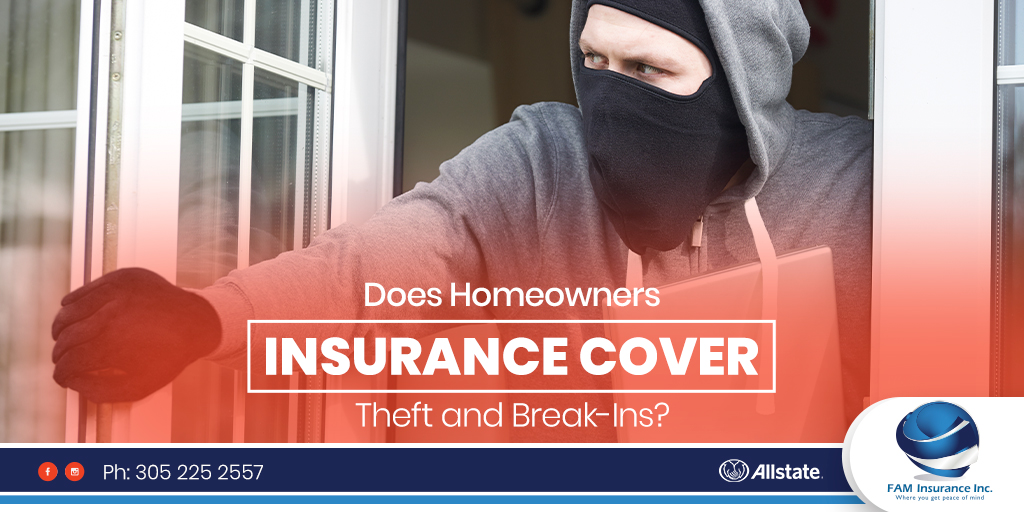Homeowners insurance may help cover theft and break-ins. Several coverages in a homeowners policy help you recover from a burglary: dwelling coverage, personal property coverage and other structures coverage.
Dwelling coverage helps pay for repairs if your home is damaged by a covered peril. This typically includes damage caused by a break-in. If an intruder breaks a window or damages your door, dwelling coverage may help pay for repairs.
Personal property coverage helps pay to replace or repair your belongings if they are stolen or damaged by a covered loss (including theft). If an intruder steals items from your home, personal property coverage may help pay to replace them.
Other structures coverage helps pay to repair detached structures on your property if they’re damaged by a covered peril. If your garage or shed is damaged during a break-in, your other structures coverage may help pay for repairs.
How Much Insurance Do I Have for Break-Ins?
As for how much you can expect your homeowners insurance to pay after a break-in, that depends on your particular policy.
Coverage Limits and Deductibles
The first thing to understand is that each coverage in a homeowners policy has a limit. A limit is the maximum amount your insurer will pay toward a covered claim. Also, keep in mind that some coverages have a deductible. A deductible is your share of the cost for a covered claim. Your agent can help you choose or adjust your homeowners insurance limits and deductibles to fit your needs.
Dwelling Coverage to Help Repair Break-in Damage
When it comes to dwelling coverage, most policies help pay to repair or replace burglary damage with same-quality materials. Odds are, the damage to your house caused by a break-in won’t reach the dwelling coverage limit you have on your home, because it may be as high as the amount required to rebuild the structure.
Personal Property Coverage to Help Replace Stolen Belongings
If you have “replacement cost” coverage for your belongings, your insurer would help reimburse you for the cost of repurchasing the item at today’s prices. But if you have “actual cash value” coverage, your insurer will likely deduct for depreciation, paying only what the stolen item would sell for today — not the cost to buy a new one.
Sub-Limits on Certain Valuable Items
Most home insurance policies provide personal property coverage for your possessions at about 50 to 70 percent of the amount of insurance you have on your home, according to the Insurance Information Institute (III). However, certain types of property, like jewelry or silverware, will likely have their own lower sub-limits. For instance, jewelry coverage might be capped at $1,000 or $2,000, the III says.
So, if someone steals your TV in a covered break-in, your personal property coverage would help reimburse you to buy a new one. But, if a high-value item, like a ring, is stolen, you’d only be reimbursed up to the sub-limit, and you’d have to pay the rest out of pocket. Your insurance agent can help you understand the limits on your coverages.
You may be able to purchase scheduled personal property coverage to increase your coverage limits on certain high-value items. And, you may find that you won’t need to pay a deductible before your insurer pays for the loss of a scheduled item.
Other Structures Coverage to Help with Garage Break-Ins
Other structures coverage comes standard on most home insurance policies. Covered structures may include a detached garage, a shed or a fence.
Your other structures coverage limit may be a percentage of your overall dwelling coverage limit — for example, 10 percent. So, if your dwelling coverage limit is $400,000, in this example you would have up to $40,000 in other structures coverage to help protect against break-in damage.
Keep in mind that other structures coverage does not cover tools or equipment that are stolen from your garage or shed. They are likely covered by your personal property coverage. Similarly, if your property is stolen from your car in the garage, your personal property coverage may help pay to replace it.
Finally, if your car that’s parked in the garage is damaged during a break-in, you’d need to make a claim on your car insurance policy. If you have comprehensive coverage, it may help pay to repair damage done to your car during a break-in.
Tips For A Burglary Insurance Claim
Would you know what to do if your home was damaged or your stuff was stolen in a burglary? Start by reporting the burglary to police, the III says. You’ll also want to promptly get in touch with your insurance agent to file a claim.
Your insurer may ask for a copy of the police report, or the case number, to process the claim. Additionally, it’s a good idea to document any property damage with photos or video and prepare a list of the stolen items (along with receipts) to provide to your insurer, the III says. If you already have a home inventory, it may expedite this process.
You’ll also want to make any emergency repairs that will help protect your home from further damage, the III says. For instance, you may immediately want to replace broken window panes or door locks that were damaged during the break-in. Be sure to save your receipts for expenses incurred during repairs, the III says, because those expenses may be reimbursed by your insurance provider.
You probably never expect to be the victim of a burglary, but if you are, knowing what to expect from your insurance afterward can be a good first step to putting the pieces back together. Contact your insurance agent if you have any questions about coverage for theft on your homeowners insurance policy.

